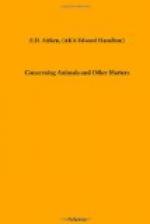Apart from all these and by itself stands a princely fisher whose bill is no modification, but an original invention and a marvellous one. Larger than a swan and gluttonous withal, the pelican cannot live on single fishes. It has given up angling altogether and taken to netting; and the way in which the net has been constructed out of the pair of forceps provided in the original plan of its construction is as well worth your examining as anything I know. It is a foot in length, the upper jaw is flat and broad, while the lower consists of two thin, elastic bones joined at the point, a mere ring to carry the curious yellow bag that hangs from it. In pictures this is represented as a creel in which the kind pelican carries home the children’s breakfast; you are allowed to see the tail of a big fish hanging out. But it is not a creel; it is a net. The great birds, marshalled in line on some broad lake or marsh, and beating the water with their wings, drive the fish before them until they have got a dense crowd huddled in panic and confusion between them and the shore. Now watch them narrowly. As each monstrous bill opens, the thin bones of the lower jaw stretch sideways to the breadth of a span by some curious mechanism not described in the books, and at the same time the shrunken bag expands into a deep, capacious net. Simultaneously the whole instrument is plunged into the struggling, silvery mass and comes up full. The side bones instantly contract again, and the upper jaw is clapped on them like a lid. No wonder the fishermen of the East detest the pelican.
[Illustration: HERE THE COMPETITION HAS BEEN VERY KEEN INDEED.]
[Illustration: AS WONDERFUL AS THE PELICAN, BUT HOW OPPOSITE!]
In the same marsh, perhaps, standing with unequalled grace upon the longest legs known in this world, is a troop of giant birds as wonderful as the pelican, but how opposite! The beautiful flamingo is a bird of feeble intellect, delicate appetite, and genteel tastes. It cannot eat fish, for its slender throat would scarcely admit a pea. Besides, the idea of catching anything, or even picking up food from the ground, does not occur to its simple mind. Its diet consists of certain small crustaceans, classed by naturalists with water-fleas, which abound in brackish water; and it has an instrument for taking these which it knows how to use. I kept flamingos once, and, after trying many things in vain, offered them bran, or boiled rice, floating in water. Then they dined, and I learned the construction and working of the most marvellous of all bills. The lower jaw is deep and hollow, and its upper edges turn in to meet each other, so that you may fairly describe it as a pipe with a narrow slit along the upper side. In this pipe lies the tongue, and it cannot get out, for it is wider than the slit, but it can be pressed against the top to close the slit, and then the lower jaw becomes an actual pipe. The root of the tongue




